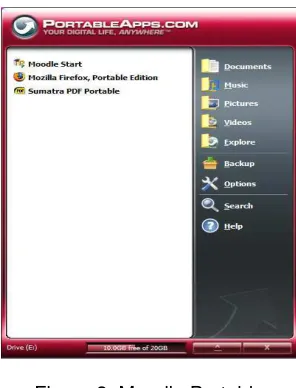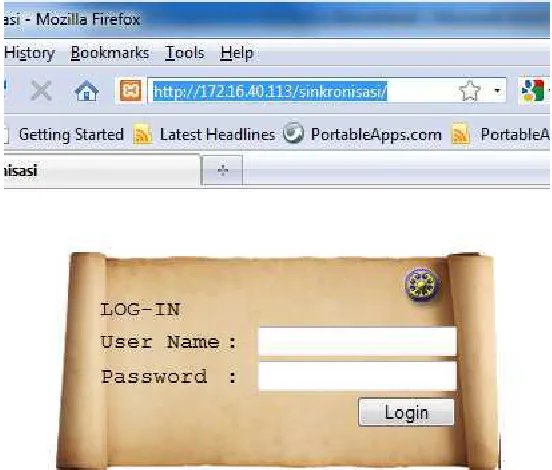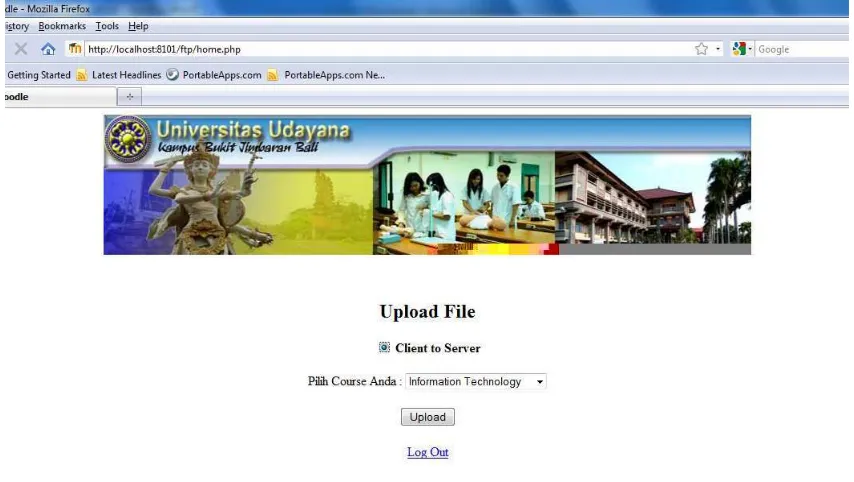TELKOMNIKA, Vol.10, No.1, March 2012, pp. 179~188 ISSN: 1693-6930
accredited by DGHE (DIKTI), Decree No: 51/Dikti/Kep/2010 179
Synchronization Interfaces for Improving Moodle
Utilization
Linawati1, Gede Sukadarmika2, GM Arya Sasmita3 Department of Electrical Engineering, Udayana University
Bali, Indonesia, phone/fax.: +62 361 703315
e-mail: linawati@unud.ac.id1, sukadarmika@ee.unud.ac.id 2, arya@ee.unud.ac.id 3
Abstrak
Sebagian besar perguruan tinggi telah menerapkan e-learning dengan menggunakan lebih dari satu LMS (learning management system) seperti Wordpress dan Moodle. Pemanfaatan e-learning di negara berkembang menimbulkan kesulitan yang terutama disebabkan oleh keterbatasan dan mahalnya infrastruktur internet. Oleh karena itu, untuk meningkatkan penggunaan Moodle dalam e-learning, maka dua antarmuka sinkronisasi ditampilkan pada paper ini, yaitu antarmuka untuk Moodle dan Wordpress, dan antarmuka untuk Moodle portabel yang berfungsi sebagai LMS offline dan Moodle yang berfungsi sebagai LMS online. Moodle portabel diinstal di dalam notebook guru dan murid, sedangkan Moodle dan Wordpress terinstal dalam server. Tujuan dari penelitian ini adalah untuk meningkatkan penggunaan Moodle dalam pembelajaran. Ada pun hasilnya sangat memuaskan. Guru dan murid mampu menggunakan kedua antarmuka ini dengan mudah dan aman, karena diperlukan guru/murid ID, mata kuliah ID, username dan password untuk login ke dalam sistem.
Kata kunci: antar muka, learning management system, Moodle, sinkronisasi
Abstract
Many universities have applied e-learning on more than one LMS (learning management system) platforms such as Wordpress and Moodle. In addition, difficulties implementations in developing countries have occurred. Those are mainly caused by limitations and expensive of internet infrastructure. Therefore to increase Moodle application as an e-learning system, the paper proposed two synchronization interfaces. The first interface is for Moodle and Wordpress. This assists teachers to migrate their learning material in their blog in Wordpress into Moodle. Second interface is for Moodle portable performing offline LMS and Moodle performing online LMS. Moodle portable was installed in teachers and students notebooks. Moodle itself was installed and run in e-learning server. The aim is to improve Moodle utilization in the class. The results showed satisfied outcomes. Students and teachers could employ the interfaces easily and secure as they have to login using student/teacher ID, course ID, username and password.
Keywords: interface, learning management system, Moodle, synchronization
1. Introduction
Mostly higher education institutions have been improving their way of learning process by utilizing LMS (learning management system) or CMS (content management system). Many kinds of open source LMSs or CMSs as e-learning system to be chosen such as Moodle, Blackboard, Wordpress, and Joomla. In order to improve e-learning service to teachers and students, an integration or synchronization between them is needed.
TELKOMNIKA Vol. 10, No. 1 Moodle in their class. As a res Wordpress, and offline Moodle
2. Learning Management Sy E-learning could be i The purpose of the use of tec effective, productive and susta However the implementation consuming. This applies to bo that technology application in results were the increase of th to the subject, their understan approval of utilizing learning Education [6]. The report co performed better than those r outcomes for online and face and control means, divided contrasting conditions that conditions taught entirely fac and the academic achievem paper presented significant r students' outcomes and satisfa LMS provided the means for h the growing body of e-learn administration of training even and records progress from lea designed to handle courses technology based, such as W rich multi-media content. Moo
1, March 2012 : 179 – 188
result the paper proposed two interfaces to synchro dle with online Moodle.
System and E-Learning
e implemented for both face-to-face meeting and echnology to deliver training material to a target au stainable manner is essential especially in higher e ion of the learning systems requires high creat
both the system and the educational content. Som in learning process yielded better students’ pe f the students’ scores; most of the students expres tanding of the subject benefit in science and engin ng media [5]. Furthermore is a report from U.S confirmed that on average, students in online le e receiving face-to-face instruction. The difference ce-to-face classes-measured as the difference be d by the pooled standard deviation-was larger t blended elements of online and face-to-face ace-to-face. The effects of competitive learning o ment of telecommunications students were exam t results on the use of competitive e-learning to isfaction.
factors to be examined before adopting an e-lea olution comprises three key elements has been pr logy, content development, and services should inable e-learning system. Technology plays a fun wing for a range on content delivery options. Figur ave positioned E-learning as a viable institution trai
-learning
Figure 2. E-learning technolo
ic expansion, networking advances, together with ence of e-learning encouraged the development o r human-resource managers to manage both class arning content. LMS is a software product tha ents [10]. The LMS registers users, tracks course learners; it also provides reports to management. A es by multiple publishers and content providers. WebCT, Moodle, etc., conferencing and discuss oodle application is getting popular in education in
TELKOMNIKA ISSN: 1693-6930 181
open-source products under GNU license. Moodle is packet software that consists of Moodle, Apache, MySQL and PHP applications [1].
Other proprietary LMS product named adaptive hypermedia courseware (AHyCo) has been implemented in a blended e-learning model [11]. The model is based on a mixture of collaborative learning, problem-based learning (PBL) and independent learning, in a course in Information Science, at the University of Rijeka, Croatia. The results showed that students were satisfied with the pedagogical approach, and their academic achievements were also better than expected. Particularly important is that the dropout rate was greatly diminished, which could be related to students' satisfaction with the support they received from the instructor and the system.
Display of a web lab through a browser delivered by an LMS as a part of SCORM standard packaging and a service-oriented architecture which allow integrating multiple LMSs (Moodle, .LRN, Claroline, etc.) with iLabs and multiples web a remote labs were proposed in [12]. On the other hand, a prototype of offline web application and task synchronization in e-learning activity addressed issue of an expensive Internet infrastructure [13]. This system utilizes the offline application capability and web storage of HTML5 enabled mobile web browser to bring an offline user interface to students. Using this system students are able synchronize their mobile phone with campus Moodle for task retrieval/submission during their time in campus and later doing the task at home without having to get online. Besides giving the concept, a prototype has been implemented to show its functionality. Furthermore intelligent Avatar for 3D tutor in e-learning system has been proposed in [14]. The Avatar which is called Emo-Avtar, is a multimodal expression of human senses. Most users gave positive response to the 3D tutor.
3. Implementation Phase
Implementation phase consists of two stages, i.e. a preparation and development stages. In this phase, Moodle was proposed to be implemented in e-learning system in electrical engineering department, Udayana University. The full package application was installed in local server and acted as online LMS. Then Wordpress was installed in web server as teachers’ personal blogs. In addition Moodle Portable was installed in teacher and students notebooks and acted as off-line LMS.
3.1. Preparation Stage
Some works should be accomplished in preparation stage. Details of works were preparing hardware and software, exploring all features and plug-ins of Moodle portable, Moodle, Wordpress, designing and implementation of synchronization interfaces tools. Figure 3 displays Moodle portable. Server, personal computers, and notebooks are major hardware in this stage.
TELKOMNIKA Vol. 10, No. 1, March 2012 : 179 – 188
Moodle as the main application was downloaded from http://www.moodle.org and run in Linux environment. The interface required supporting from other applications, i.e. PHP, MySQL, SSH, Apache, HTML, and Java script.
3.2. Development Stage
3.2.1. Interface of Wordpress and Moodle
In development stage, two-ways synchronization interface was designed and developed. Synchronization only can be done by authenticated users for example authentication of course id, student id, username and password. Therefore the system is secured. Moreover the interface will help teachers to insert their learning materials automatically from Wordpress into Moodle by simply clicking interface button. Figure 4 describes the synchronization process between Moodle and Wordpress.
Figure 4. The synchronization design of Wordpress and Moodle
3.2.2. Interface of Moodle Portable and Moodle
Similar with interface of Wordpress and Moodle, the system is designed secure. Barely authenticated users be able to log into the system. Moreover the interface will help students and teachers in doing the assignments, learning and preparing materials in Moodle without Internet connection. They can upload their assignments and materials directly into Moodle in e-learning server by simply clicking interface button. The assignments will be inserted automatically into their students’ pages in Moodle. Figure 5 describes the synchronization process between offline LMS (Moodle portable) and online LMS (Moodle in the server).
When the students need to upload or download from Moodle to their Moodle portable or vice versa, they have to choose synchronization types. They select server-to-client synchronization when they download assignments or learning material from Moodle. In addition, client-to-server synchronization is selected, when the students upload their assignments or quiz. At synchronization process, Insert Into of PHP function for MySql is applied to insert database from master to slave. Moreover, update function is used to update the database in both Moodle and Moodle portable.
4. Results and Analysis
4.1. Synchronization of Wordpress and Moodle
A two-ways synchronization interface for Wordpress and Moodle yields good results. The synchronization has good security as it is implemented only by authenticated users. Figures 6 and 7 present the interface implementations.
E-learning Server
http://belajar.unud.ac.id
(Moodle) Teacher’s Blog Server
http://staff.unud.ac.id/~t eacher_name
(WordPress)
Interface
Student Teacher
...
course id, student’s id, username, password
course id, Teacher id, username, password
Student Student
TELKOMNIKA
Figure 5. The sy
Figu
4.1.1. Interface of Wordpress Below are steps to di Moodle:
Student (Moodle Portable)
Course id, student id, username, password
ISSN: 1693-6930
synchronization design of Moodle Portable and Mo
igure 6. RSS feeds configuration in Moodle
ess to Moodle
display personal blog used Wordpress into e-learn Server e-learning
http://belajar.unud.ac.id
(Moodle)
le le)
Teacher (Moodle Portable)
...
Course id, Teacher id, username, password
Students (Moodle Portable)
Students (Moodle Portable)
183
oodle
arning system used ts
- Click add/edit feeds, follow - ‘Editing on’ menu for addin
Figur
4.1.2. Interface of Moodle to On the other hand, le RSS too, as presented in Figu as follows: d.ac.id/eng/?feed=rss2. Moodle in default mode ha a plug-in must be added. Newsfeed is the plug-in
ocks directory of Moodle.
inistrator, and then choose notifications. red, choose continue.
to set RSS feed as follows. In administrator page, rss feeds. There are three options as seen in Fig. 6 SS, ‘Timeout’ is for decision of RSS feed expired, a
thorization to add or edit RSS feed.
owed by RSS address of site and click Add, then Sa ing or editing the RSS feed.
gure 7. Blog (Wordpress) displays in Moodle
to Wordpress
, learning contents in Moodle can be displayed in igure. 8. However RSS of Moodle has to be create
nt_activity.php, config_instance.html, and rsslib.p irectory /rss.
her in the course page which the RSS will be prese tton, then at blocks, choose recent activity.
y activating enable rss feeds.
n wordpress by login as an administrator in wordp ript below into wordpress page (HTML).
TELKOMNIKA
Figu
Figure 9
4.2. Synchronization of Moo A two-ways synchron LMS) yields good results. The
ISSN: 1693-6930
igure 8. Moodle displays in Wordpress page
e 9. The synchronization command in Moodle
oodle Portable and Moodle
nization interface for Moodle Portable (offline LMS he interface application has to recognize as a teac
185
TELKOMNIKA Vol. 10, No. 1, March 2012 : 179 – 188
As a teacher, someone has to set up a course in e-learning server and register in the server (http://172.16.40.113/moodle/) to get username and password. When the teacher or student uploads or downloads learning materials, she/he selects synchronization command and login in (http://172.16.40.113/sinkronisasi/), as seen in Figure 9 and 10.
Figure 10 presents that both students and teachers have to type the username and password in the synchronization page. The username and password have to be the same as in the Moodle account. Then Figure 11 displays the synchronization types, either server-to-client or client-to-server options. Server-to-Client command is for downloading and Client-to-Server is for uploading from users sides.
Figure 10. The synchronization web-page
TELKOMNIKA ISSN: 1693-6930 187
In the Moodle portable (http://localhost:8101/moodle/), both teacher and students can create and prepare quiz, lesson, slides, etc. in any type of file such as .doc, .pdf, .ppt, etc. To do that, they have to login with the same Id as in the Moodle in e-learning server. In particular to upload .doc, .pdf, .ppt file, they have to open web browser http://localhost:8101/ftp/ as shown in Figure 12. The synchronization utilized php and mySQL scripts, i.e. insert into and update functions. The synchronization has its own webpage, however employs database of Moodle.
Figure 12. Upload file webpage
5. Conclusion
Throughout the research, Moodle has been enhanced its features for e-learning by developing two-ways synchronization interfaces for both Wordpress with Moodle, and Moodle Portable performing offline LMS with Moodle performing online LMS. The interfaces have worked well to assist teachers and students using Moodle, especially in developing countries where the Internet connection is still a big issue. They are simple to use and have high security system, since course id, user id, user name, and password are required to login the system. Thus the interface is expected to increase the efficiency of teaching and at the same time is effective for learning. Therefore, they can take advantage of the synchronization interfaces. Further work will develop the interfaces for mobile learning with various mobile devices.
Acknowledgement
This publication is result of research work that was funded by Indonesia Directorate General Higher Education. The authors also thank to Dr. Ir. Achmad Affandi, DEA (ITS-Surabaya) and Prof. Dr. Tsuyoshi Usagawa (Kumamoto Univ., Japan) for their valuable advices and feedbacks.
References
[1] Kumar S, Gankotiya AK, Dutta K. A comparative study of moodle with other e-learning systems. 3rd International Conference on Electronics Computer Technology (ICECT). 2011; 5; 414-418.
TELKOMNIKA Vol. 10, No. 1, March 2012 : 179 – 188
[3] Kazunori Nozawa. To Moodle or not to Moodle: Can It Be an Ideal e-Learning Environment?. DOI=
http://www.ps.ritsumei.ac.jp/assoc/policy_science/183/183_19_nozawa.pdf
[4] Guido Rößling and Andreas Kothe. Extending Moodle to Better Support Computing Education. In the Proceeding of the ITiCSE’09. July 6–9, 2009, Paris, France.
[5] Linawati and D.M. Wiharta. E-Learning: Multimedia Application on Digital Signal Processing. In the Proceedings of the International Symposium on Open, Distance, and E-learning. 2007: 13-15. [6] U.S. Department of Education, Office of Planning, Evaluation, and Policy Development, 2009.
Evaluation of Evidence-Based Practices in Online Learning: A Meta-Analysis and Review of Online Learning Studies. Washington, D.C. DOI= www.ed.gov/about/offices/list/opepd/ppss/reports.html [7] Regueras LM, Verdu E, Munoz MF, Perez MA, de Castro JP, Verdu MJ. Effects of Competitive
E-Learning Tools on Higher Education Students: A Case Study. IEEE Transactions on Education. May 2009; 52(2): 279-285.
[8] Henry, P. E-learning Technology, Content and Services. Education & Training. 2001; 43.
[9] Butler Group. Cultural and Financial Implications of an E-learning Approach. Butler Group’s Intelligence Journal. April 2002.
[10] American society for training and development (ASTD) glossary of terms. DOI=
http://www.learningcircuits.org/glossary.html
[11] Hoic-Bozic, N. Mornar, V. Boticki, I. A Blended Learning Approach to Course Design and Implementation. IEEE Transaction on Education. Feb. 2009; 52(1): 19-30.
[12] Sancristobal E, Castro M, Harward J, Baley P, DeLong K, Hardison J. Integration view of Web Labs and Learning Management Systems. IEEE Conference on Education Engineering (EDUCON). 2010: 1409-1417.
[13] Ijtihadie RM, Chisaki Y, Usagawa T, Cahyo HB, Affandi A. Offline web application and quiz synchronization for e-learning activity for mobile browser. IEEE Region 10 Technical Conference (TENCON). 2010: 2402-2405.



